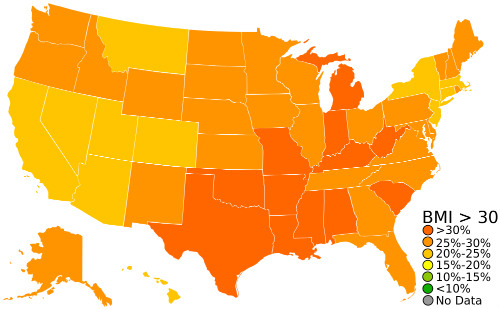- Prediabetes increasingly detected in middle-aged Americans with normal BMI.
- All patients should be tested for diabetes and prediabetes.
- Researchers attribute rise in pre-diabetes to sedentary lifestyle.
- Studies have shown sitting and a sedentary lifestyle to be a significant health risk.
- Sitting for more than 3 hours per day cuts life expectancy by at least 3 years.
- Extended TV watching also tied to decreased lifespan.
Sitting and television watching have been tied to increased levels of prediabetes, diabetes, and death among Americans. A study published recently in BMJ Open linked extended sitting and television viewing with increased mortality. A study published in the Annals of Family Medicine found that rates of diabetes and pre-diabetes are rising among healthy-weight, relatively young Americans. The diabetes researchers identified a link between a sedentary lifestyle and diabetes, irrespective of body weight, body mass index (BMI), or waist circumference. (Figures 1 and 2.)

(Sources: Wikipedia/Creative Commons/By Falcorian - Own work.)
(Darker colors indicate longer lifespan.)
(Sources: Wikimedia/Creative Commons/By TastyCakes on English Wikipedia.)
“Reducing sedentary behaviours such as sitting and television viewing may have the potential to increase life expectancy in the USA”, concluded the authors of the meta-analysis published in BMJ Open.
According to this study, it appears that sitting for ≥3 hours/day can reduce your patient’s life expectancy by two years, even if s/he engages in physical activity and refrains from dangerous habits such as smoking. Additionally, watching TV for ≥2 hours/day can further reduce life expectancy—by another 1.4 years or so.
The meta-analysis analyzed 5 studies including nearly 167,000 people aged 4 to 14 years. This finding comes just two years after Australian researchers found that people who watched TV for ≥4 hours/day 46% more likely to die of any cause than were people who said that they ≤2hours/day watching TV. Those who reported watching TV for ≥4 hours/day were also 80% more likely to die of cardiovascular disease.
"Sedentary behavior is something we need to take note of beyond telling people to get 30 minutes of activity a day," explained Peter T. Katzmarzyk, PhD. "We have people who can meet that guideline. However, if you're sedentary or sitting the other 20 hours a day, you're still going to be at risk for that,” he said. Dr. Katzmarzyk is Professor and Marie Edana Corcoran Endowed Chair of Pediatric Obesity and Diabetes at the Pennington Biomedical Research Center of Louisiana State University. He also Associate Executive Director for Population and Public Health Sciences at Pennington and was involved in the meta-analysis published in BMJ Open.

Scientists also recently found that exercise reduces the risk of developing 26 types of cancer. See our related report here.
Because, being physically active does not offset the damage of sitting, it is important for desk-bound workers to simply stand as often as possible, for as long as possible.
"Try to stand as much as you can," Dr. Katzmarzyk said. "Typically when you're on the telephone you can stand with speaker phone. Instead of emailing someone in the office, just get up and go talk to them," he said.
Sitting appears to cause nearly complete relaxation of the leg muscles. This lack in turn causes a significant decrease in glucose metabolism in the lower extremity muscles and alters the body’s ability to metabolize glucose globally which can precipitate pre-diabetes or diabetes, even in physically active individuals.
Prediabetes and Diabetes and Individuals with Health Bodyweight
“Among individuals within a healthy BMI range, the prevalence of prediabetes and abdominal obesity has substantially increased. Abdominal obesity does not appear to be the primary cause of the increase,” explained the authors of the study published in Annals of Family Medicine.
They analyzed data from the National Health and Nutrition Examination Survey (NHANES) III (1988–1994) and NHANES for the years 1999 to 2012. The authors focused on adults aged ≥20 years who had BMI of 18.5 to 24.99—within the normal range—and did not have diabetes. “We defined prediabetes using glycated hemoglobin (HbA1c) level ranges from 5.7% to 6.4%, as specified by the American Diabetes Association,” they explained. “Abdominal obesity was measured by waist circumference and waist-to-height ratio.”
Even among this group of apparently healthy, young-to-middle-aged people, the prevalence of prediabetes increased from 10.2% in 1988–1994 to 18.5% in 2012. Among individuals aged 45 years and older, the prevalence of prediabetes increased from 22.0% to 33.1% during this same period.
The percentage of adults aged 20 years and older with an unhealthy waist circumference increased from 5.6% in 1988–1994 to 7.6% in 2012. The percentage of individuals with an unhealthy waist-to-height ratio increased from 27.2% in 1988–1994 to 33.7% in 2012. Adjusted models found that measures of abdominal obesity were not independent predictors of prediabetes among adults with a healthy BMI.

"We have some strong data that says we need to rethink our model of what we think is healthy. This may require a paradigm shift so that we're not just looking for diabetes in the overweight and obese," he said.
"Saying that sitting is the new smoking sounds trite, but there's a certain level of truth to it," Dr. Mainous said.
